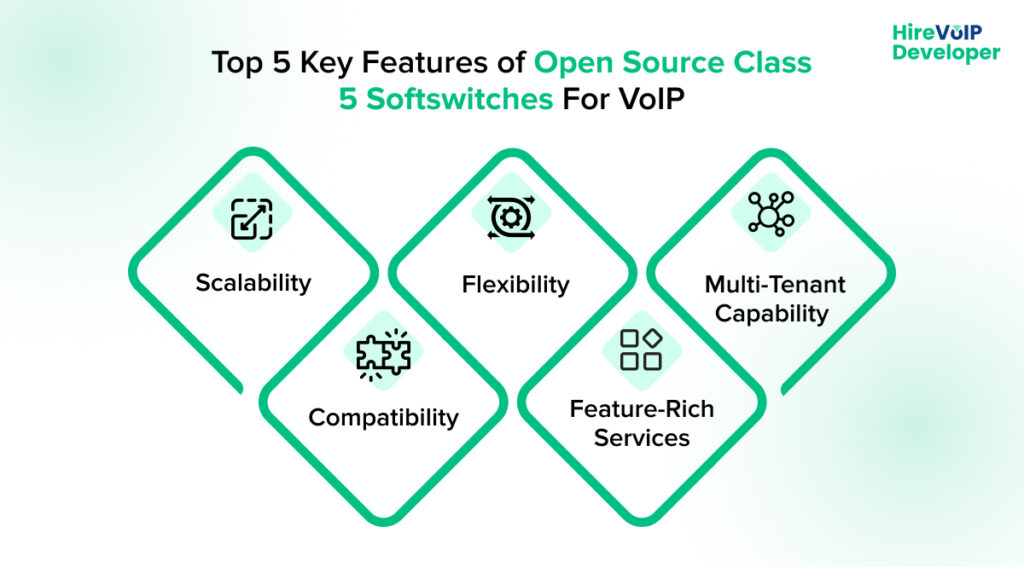We have worked with global leaders in the VoIP industry for more than 17+ years. During this time, the telecom industry has experienced some rapid evolution over the past few years. This rapid evolution is driven by businesses’ increasing need for efficient, scalable, cost-effective communication solutions. As businesses rely heavily on digital communication mediums today, robust telecom infrastructure is not only a requirement but also a critical part of business operations that helps drive your organization’s growth.
Innovative technology called Open Source Class 5 Softswitches fills this gap. This open-source technology powers your VoIP system and enables seamless call routing and management for digital communication solutions. It plays a key role in VoIP development by supporting scalability and flexibility in modern communication systems. Want to know more about this innovative open-source technology, SoftSwitch? Congratulations, you are at the right place.
In this blog, we will discuss how this technology has emerged as a game changer in the telecom sector and how you can utilize it in your telecom business. Before discussing how this open-source technology, Class 5 Switch, transforms communication solutions in the telecommunication industry, let’s first understand SoftSwitch and how this technology works behind the scenes.
What is Open Source Class 5 SoftSwitch?
A Class 5 Softswitch is an open-source technology used in the telecom industry to build telecommunication networks and handle voice services for end users. An open-source class 5 softswitch serves as the backbone for digital communication in business environments, supporting cost-effective and efficient communication systems.
This Open-source telecom software also provides primary functions, such as call routing, call switching, call management, and media and protocol conversion.
Maximize scalability and flexibility with open-source Class 5 Softswitch.
Top 5 Key Features of Open Source Class 5 Softswitches For VoIP
Now that you understand an open-source Class 5 Softswitch, it is time to explore this open-source technology’s features.

1. Scalability
With advanced class 5 softswitch features, these systems are specifically designed to manage the increasing number of users and calls. They can easily scale up or down to meet changing demands, making them ideal for small businesses, large enterprises, and regional telecom operators, all without sacrificing efficiency or performance.
2. Compatibility
Telecom operators favor open-source class 5 softswitch solutions primarily due to their compatibility features. A Class 5 Softswitch allows for seamless integration of telecom networks with various devices and protocols. Whether using legacy systems or modern IP-based technologies, you can effectively manage different system configurations within your telecom network.
3. Flexibility
Service providers can customize open-source Softswitch for VoIP to meet specific business models, user preferences, or operational requirements, providing tailored solutions for various markets.
4. Feature-Rich Services
An open-source class 5 softswitch is a full-featured packaged open-source technology. It has basic features such as call management and advanced functionality like video conferencing, instant messaging, unified communication, and virtual PBX systems, which help you create a perfect communication suit.
5. Multi-Tenant Capability
The multi-tenant capability of open-source Softswitch for VoIP allows you to serve many customers on a single platform. This feature is ideal for hosting providers who need to handle a diverse client base. By sharing infrastructure among multiple tenants, organizations can reduce hosting and infrastructure costs by up to 75%.
Use Cases and Real-World Examples
To maximize the benefits of Open-source telecom software, we must explore real-world applications and user cases of open-source solutions rather than just understanding its features.
1. Vonage’s Adoption of Open Source Technology
Vonage is a well-established and reputable brand in the cloud communication services market. Its VoIP infrastructure uses open-source technologies like Open source Softswitch for VoIP, enabling it to provide customized customer services.
2. ISPs in Emerging Markets
Internet Service Providers (ISPs) use open-source Class 5 Softswitches to provide affordable Voice over Internet Protocol (VoIP) services, especially in Southeast Asia and Africa. These cost-effective solutions help local providers offer high-quality services at low prices, allowing them to compete well with larger telecom companies.
3. Startups in the Telecom Sector
The Open-source softswitch for telecom has changed the landscape for telecom startups.. Companies use this open-source technology to create new communication solutions, like cloud-based contact centers and mobile VoIP apps. They also take advantage of the flexibility and scalability that open-source technologies offer.
4. Call Center Operations
Managing inbound and outbound communications in call centers is an effort-consuming operation, and open source class 5 softswitch is pretty good at it. Additionally, it helps with valuable features such as automatic call description (ACD), interactive voice response (IVR), and call recording, which help call centers to provide a smooth customer experience and optimize various call center operations.
Challenges of Open Source Class 5 Softswitches For Telecom
1. Lack of Vendor Accountability
Unlike proprietary systems, where vendors are responsible for providing guaranteed support and updates, class 5 softswitch open-source solutions depend on community-driven development. This can lead to uncertainties regarding long-term support, feature enhancements, or timely resolution of critical issues.
2. Technical Expertise and Support
Deploying and managing an open-source class 5 softswitch for VoIP often requires high technical expertise. Unlike proprietary solutions with vendor support, open-source systems typically rely on community forums and documentation for troubleshooting. Organizations may need to hire skilled developers or train their existing teams, which can increase upfront costs.
Many telecom providers also find setting up FreeSWITCH as a WebRTC MCU server challenging. However, with the proper guidance, this can be simplified. To overcome this challenge, follow our detailed guide on Configure FreeSWITCH as a WebRTC MCU Server.
3. Customization Complexity
While Open source Softswitch for VoIP solutions offers flexibility, extensive customization can become complex and time-consuming. Poorly managed modifications might lead to integration issues, system instability, or difficulty scaling the solution as the business grows.
The Future of Open Source Class 5 Softswitches in Telecom
The future of telecommunications is changing quickly due to new technology and customer needs. Class 5 Softswitch open-source solutions are leading this change and creating opportunities for growth and innovation in the telecom industry.
1. Integration with AI and Machine Learning
Class 5 Softswitch open source is well-suited for integrating AI and machine learning tools to enhance call management, fraud detection, and predictive analytics. These advancements improve user experience, optimize operations, and enable personalized communication services.
2. Accelerated Digital Transformation
As businesses and consumers embrace digital-first strategies, the demand for robust and scalable communication infrastructure continues to rise. Class 5 Softswitch open-source solutions provide the flexibility to adapt to emerging technologies such as 5G, IoT, and AI-driven communication systems, ensuring telecom operators remain competitive in a rapidly changing market.
3. Enabling Decentralized Telecom Models
The future of telecom is moving toward decentralized and cloud-based models. Open-source solutions align perfectly with this trend, allowing telecom operators to deploy virtualized communication systems that reduce reliance on traditional hardware while increasing operational efficiency.
Hire FreeSWITCH developers to help manage and optimize cloud-based FreeSWITCH solutions, enabling a more flexible and efficient telecom model.
4. Empowering Small and Medium Operators
Open source Class 5 Softswitches lower the barriers to entry for smaller telecom operators and ISPs, enabling them to compete with more significant players. By offering cost-effective and scalable solutions, these operators can expand their services to underserved markets, driving growth in the telecom sector.
Enhance your business with affordable Class 5 Softswitch solutions.
Conclusion
Open-source Class 5 Softswitches are changing the telecom industry by providing flexible, scalable, and affordable solutions. While there are challenges like customization and security, the advantages help improve services and support global growth.
The future looks promising with new developments in AI and cloud-based technologies, which improve connectivity and make operations more efficient. Hire a VoIP Developer today. Get expert help to set up Open Source Softswitch for VoIP that fits your business needs. Contact us now.



